MGT100: Analyzing the Impact of Silence in Organizational Culture
VerifiedAdded on 2023/06/15
|7
|1698
|352
Report
AI Summary
This report provides a comprehensive analysis of an article discussing the detrimental effects of organizational silence, where employees and managers refrain from speaking up about concerns, wrongdoings, or issues within the workplace. The analysis identifies the main argument, assumptions, limitations, research methodology, and key findings of the article. It highlights that silence stems from fear of confrontation, harassment, or negative feedback, and it underscores the importance of fostering a safe and open communication environment. The report also suggests practical applications for addressing this issue, such as changing perspectives, promoting considerate communication, and ensuring employee safety and comfort. Relevant journal articles are cited, emphasizing the impact of workplace bullying and the need for ethical decision-making to improve organizational culture and productivity. Desklib provides a platform to access this and many other solved assignments and past papers.
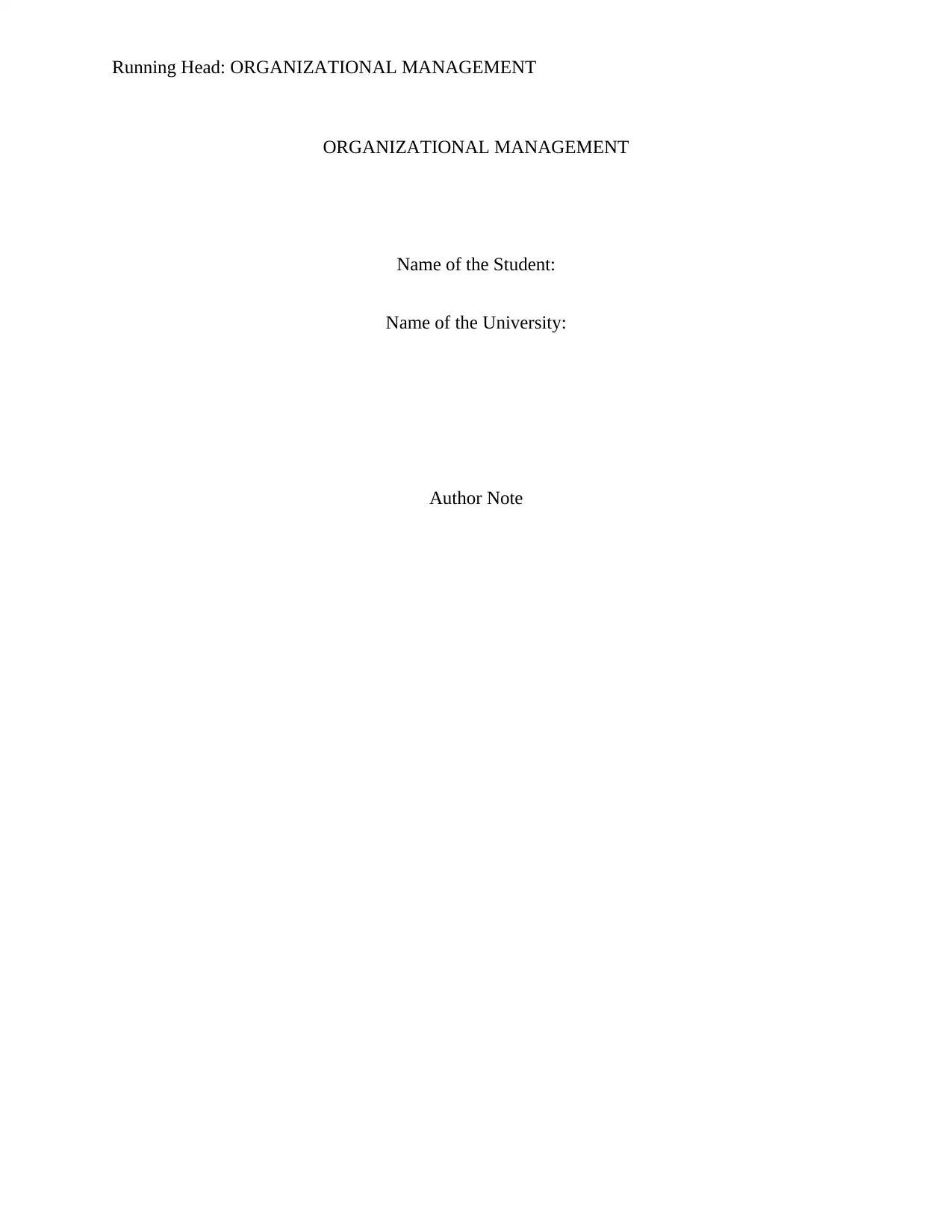
Running Head: ORGANIZATIONAL MANAGEMENT
ORGANIZATIONAL MANAGEMENT
Name of the Student:
Name of the University:
Author Note
ORGANIZATIONAL MANAGEMENT
Name of the Student:
Name of the University:
Author Note
Paraphrase This Document
Need a fresh take? Get an instant paraphrase of this document with our AI Paraphraser
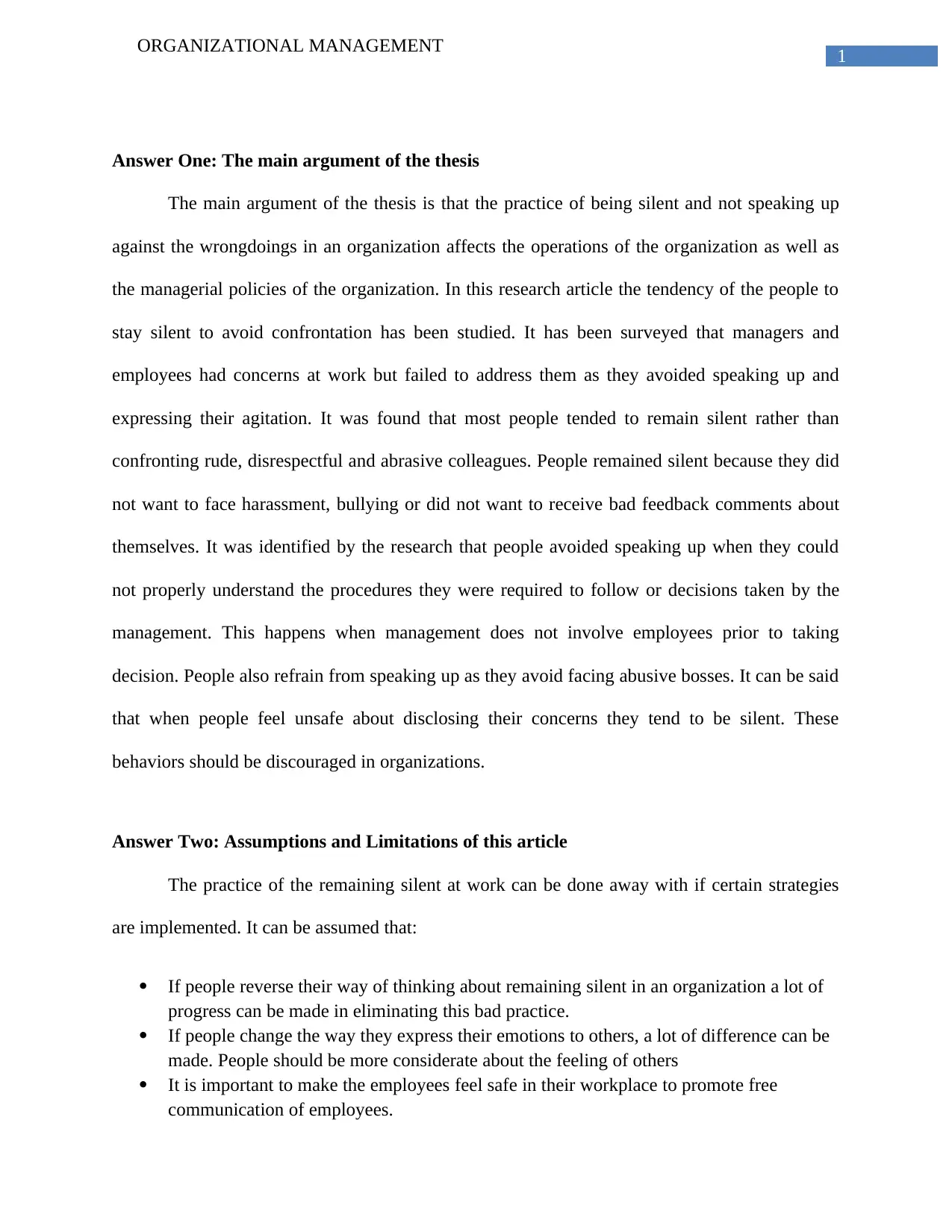
1
ORGANIZATIONAL MANAGEMENT
Answer One: The main argument of the thesis
The main argument of the thesis is that the practice of being silent and not speaking up
against the wrongdoings in an organization affects the operations of the organization as well as
the managerial policies of the organization. In this research article the tendency of the people to
stay silent to avoid confrontation has been studied. It has been surveyed that managers and
employees had concerns at work but failed to address them as they avoided speaking up and
expressing their agitation. It was found that most people tended to remain silent rather than
confronting rude, disrespectful and abrasive colleagues. People remained silent because they did
not want to face harassment, bullying or did not want to receive bad feedback comments about
themselves. It was identified by the research that people avoided speaking up when they could
not properly understand the procedures they were required to follow or decisions taken by the
management. This happens when management does not involve employees prior to taking
decision. People also refrain from speaking up as they avoid facing abusive bosses. It can be said
that when people feel unsafe about disclosing their concerns they tend to be silent. These
behaviors should be discouraged in organizations.
Answer Two: Assumptions and Limitations of this article
The practice of the remaining silent at work can be done away with if certain strategies
are implemented. It can be assumed that:
If people reverse their way of thinking about remaining silent in an organization a lot of
progress can be made in eliminating this bad practice.
If people change the way they express their emotions to others, a lot of difference can be
made. People should be more considerate about the feeling of others
It is important to make the employees feel safe in their workplace to promote free
communication of employees.
ORGANIZATIONAL MANAGEMENT
Answer One: The main argument of the thesis
The main argument of the thesis is that the practice of being silent and not speaking up
against the wrongdoings in an organization affects the operations of the organization as well as
the managerial policies of the organization. In this research article the tendency of the people to
stay silent to avoid confrontation has been studied. It has been surveyed that managers and
employees had concerns at work but failed to address them as they avoided speaking up and
expressing their agitation. It was found that most people tended to remain silent rather than
confronting rude, disrespectful and abrasive colleagues. People remained silent because they did
not want to face harassment, bullying or did not want to receive bad feedback comments about
themselves. It was identified by the research that people avoided speaking up when they could
not properly understand the procedures they were required to follow or decisions taken by the
management. This happens when management does not involve employees prior to taking
decision. People also refrain from speaking up as they avoid facing abusive bosses. It can be said
that when people feel unsafe about disclosing their concerns they tend to be silent. These
behaviors should be discouraged in organizations.
Answer Two: Assumptions and Limitations of this article
The practice of the remaining silent at work can be done away with if certain strategies
are implemented. It can be assumed that:
If people reverse their way of thinking about remaining silent in an organization a lot of
progress can be made in eliminating this bad practice.
If people change the way they express their emotions to others, a lot of difference can be
made. People should be more considerate about the feeling of others
It is important to make the employees feel safe in their workplace to promote free
communication of employees.
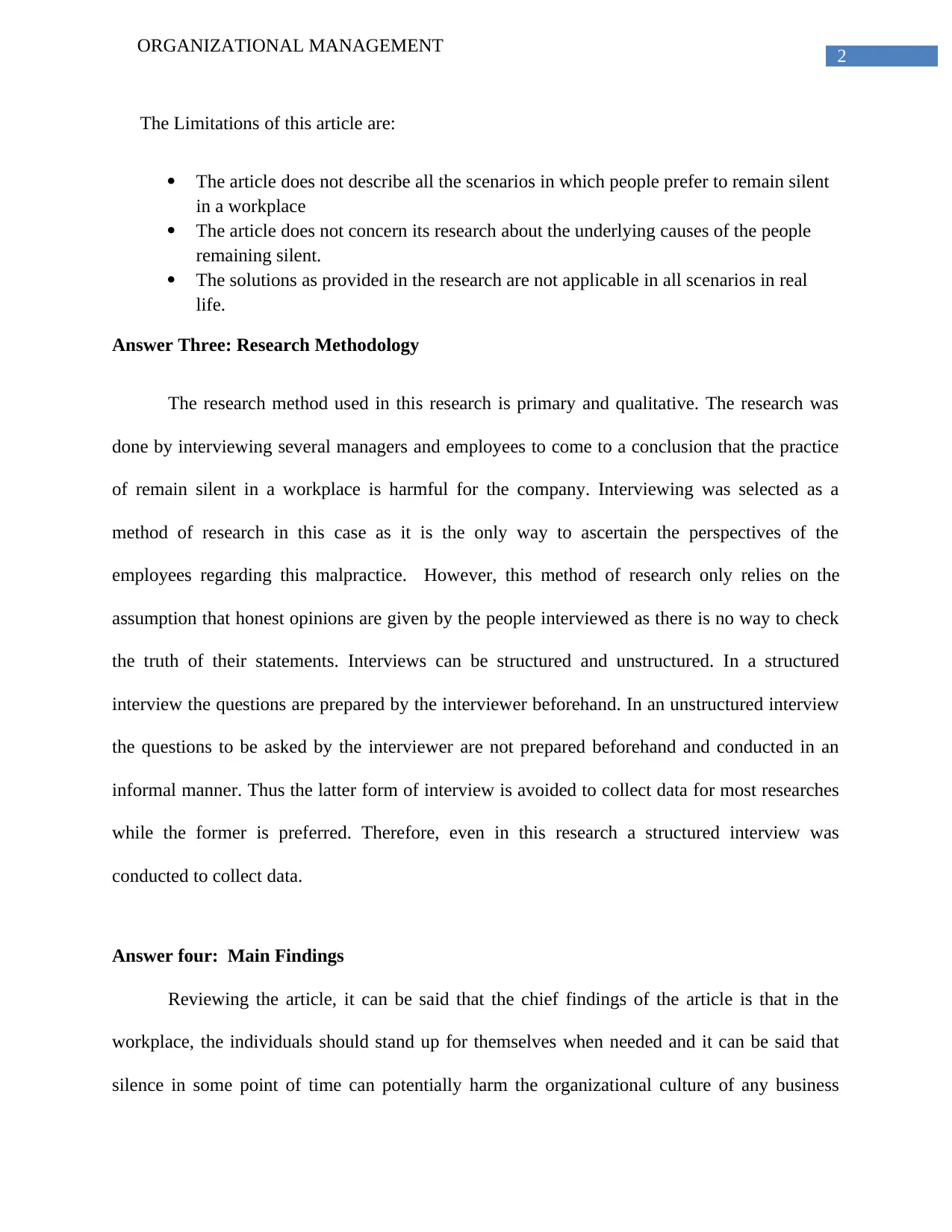
2
ORGANIZATIONAL MANAGEMENT
The Limitations of this article are:
The article does not describe all the scenarios in which people prefer to remain silent
in a workplace
The article does not concern its research about the underlying causes of the people
remaining silent.
The solutions as provided in the research are not applicable in all scenarios in real
life.
Answer Three: Research Methodology
The research method used in this research is primary and qualitative. The research was
done by interviewing several managers and employees to come to a conclusion that the practice
of remain silent in a workplace is harmful for the company. Interviewing was selected as a
method of research in this case as it is the only way to ascertain the perspectives of the
employees regarding this malpractice. However, this method of research only relies on the
assumption that honest opinions are given by the people interviewed as there is no way to check
the truth of their statements. Interviews can be structured and unstructured. In a structured
interview the questions are prepared by the interviewer beforehand. In an unstructured interview
the questions to be asked by the interviewer are not prepared beforehand and conducted in an
informal manner. Thus the latter form of interview is avoided to collect data for most researches
while the former is preferred. Therefore, even in this research a structured interview was
conducted to collect data.
Answer four: Main Findings
Reviewing the article, it can be said that the chief findings of the article is that in the
workplace, the individuals should stand up for themselves when needed and it can be said that
silence in some point of time can potentially harm the organizational culture of any business
ORGANIZATIONAL MANAGEMENT
The Limitations of this article are:
The article does not describe all the scenarios in which people prefer to remain silent
in a workplace
The article does not concern its research about the underlying causes of the people
remaining silent.
The solutions as provided in the research are not applicable in all scenarios in real
life.
Answer Three: Research Methodology
The research method used in this research is primary and qualitative. The research was
done by interviewing several managers and employees to come to a conclusion that the practice
of remain silent in a workplace is harmful for the company. Interviewing was selected as a
method of research in this case as it is the only way to ascertain the perspectives of the
employees regarding this malpractice. However, this method of research only relies on the
assumption that honest opinions are given by the people interviewed as there is no way to check
the truth of their statements. Interviews can be structured and unstructured. In a structured
interview the questions are prepared by the interviewer beforehand. In an unstructured interview
the questions to be asked by the interviewer are not prepared beforehand and conducted in an
informal manner. Thus the latter form of interview is avoided to collect data for most researches
while the former is preferred. Therefore, even in this research a structured interview was
conducted to collect data.
Answer four: Main Findings
Reviewing the article, it can be said that the chief findings of the article is that in the
workplace, the individuals should stand up for themselves when needed and it can be said that
silence in some point of time can potentially harm the organizational culture of any business
⊘ This is a preview!⊘
Do you want full access?
Subscribe today to unlock all pages.

Trusted by 1+ million students worldwide
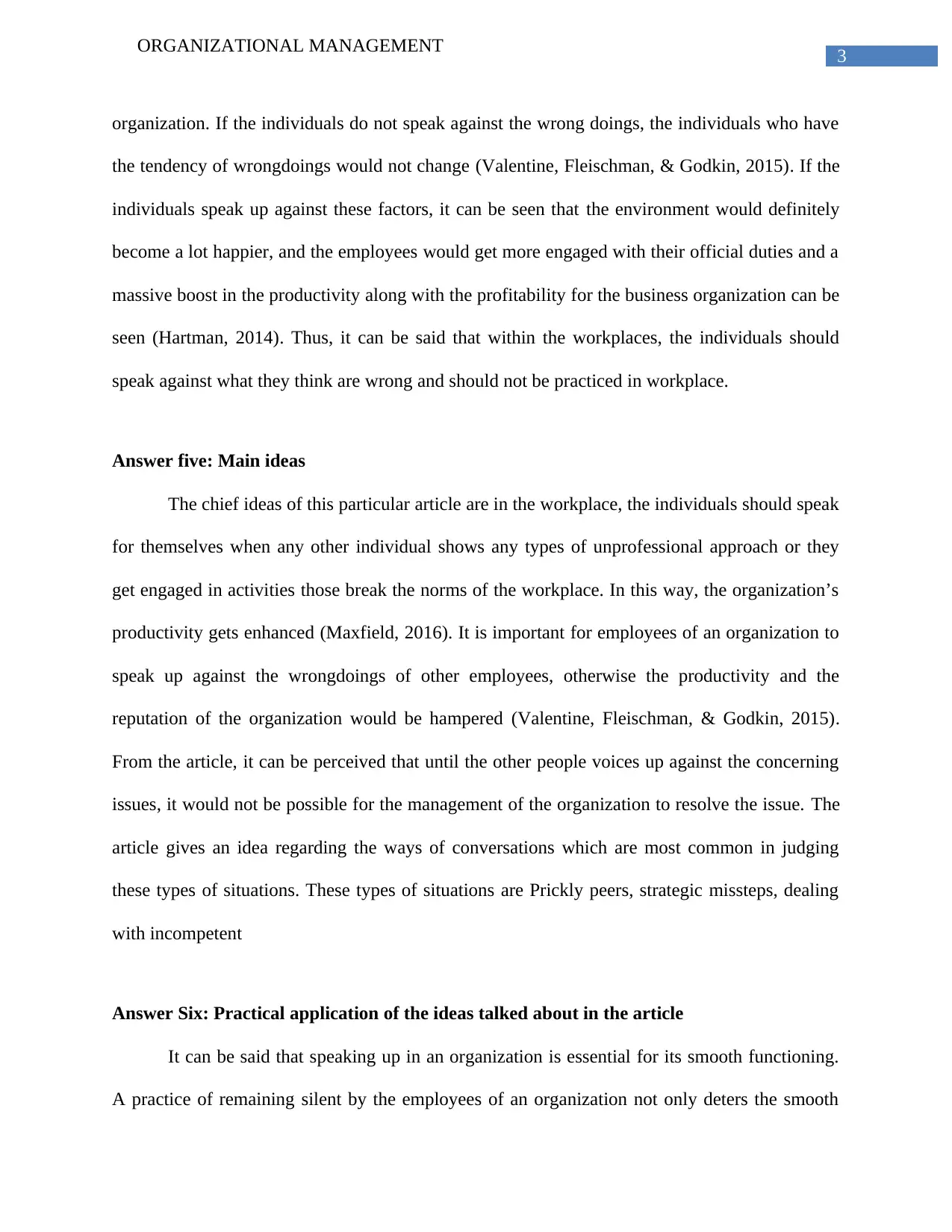
3
ORGANIZATIONAL MANAGEMENT
organization. If the individuals do not speak against the wrong doings, the individuals who have
the tendency of wrongdoings would not change (Valentine, Fleischman, & Godkin, 2015). If the
individuals speak up against these factors, it can be seen that the environment would definitely
become a lot happier, and the employees would get more engaged with their official duties and a
massive boost in the productivity along with the profitability for the business organization can be
seen (Hartman, 2014). Thus, it can be said that within the workplaces, the individuals should
speak against what they think are wrong and should not be practiced in workplace.
Answer five: Main ideas
The chief ideas of this particular article are in the workplace, the individuals should speak
for themselves when any other individual shows any types of unprofessional approach or they
get engaged in activities those break the norms of the workplace. In this way, the organization’s
productivity gets enhanced (Maxfield, 2016). It is important for employees of an organization to
speak up against the wrongdoings of other employees, otherwise the productivity and the
reputation of the organization would be hampered (Valentine, Fleischman, & Godkin, 2015).
From the article, it can be perceived that until the other people voices up against the concerning
issues, it would not be possible for the management of the organization to resolve the issue. The
article gives an idea regarding the ways of conversations which are most common in judging
these types of situations. These types of situations are Prickly peers, strategic missteps, dealing
with incompetent
Answer Six: Practical application of the ideas talked about in the article
It can be said that speaking up in an organization is essential for its smooth functioning.
A practice of remaining silent by the employees of an organization not only deters the smooth
ORGANIZATIONAL MANAGEMENT
organization. If the individuals do not speak against the wrong doings, the individuals who have
the tendency of wrongdoings would not change (Valentine, Fleischman, & Godkin, 2015). If the
individuals speak up against these factors, it can be seen that the environment would definitely
become a lot happier, and the employees would get more engaged with their official duties and a
massive boost in the productivity along with the profitability for the business organization can be
seen (Hartman, 2014). Thus, it can be said that within the workplaces, the individuals should
speak against what they think are wrong and should not be practiced in workplace.
Answer five: Main ideas
The chief ideas of this particular article are in the workplace, the individuals should speak
for themselves when any other individual shows any types of unprofessional approach or they
get engaged in activities those break the norms of the workplace. In this way, the organization’s
productivity gets enhanced (Maxfield, 2016). It is important for employees of an organization to
speak up against the wrongdoings of other employees, otherwise the productivity and the
reputation of the organization would be hampered (Valentine, Fleischman, & Godkin, 2015).
From the article, it can be perceived that until the other people voices up against the concerning
issues, it would not be possible for the management of the organization to resolve the issue. The
article gives an idea regarding the ways of conversations which are most common in judging
these types of situations. These types of situations are Prickly peers, strategic missteps, dealing
with incompetent
Answer Six: Practical application of the ideas talked about in the article
It can be said that speaking up in an organization is essential for its smooth functioning.
A practice of remaining silent by the employees of an organization not only deters the smooth
Paraphrase This Document
Need a fresh take? Get an instant paraphrase of this document with our AI Paraphraser
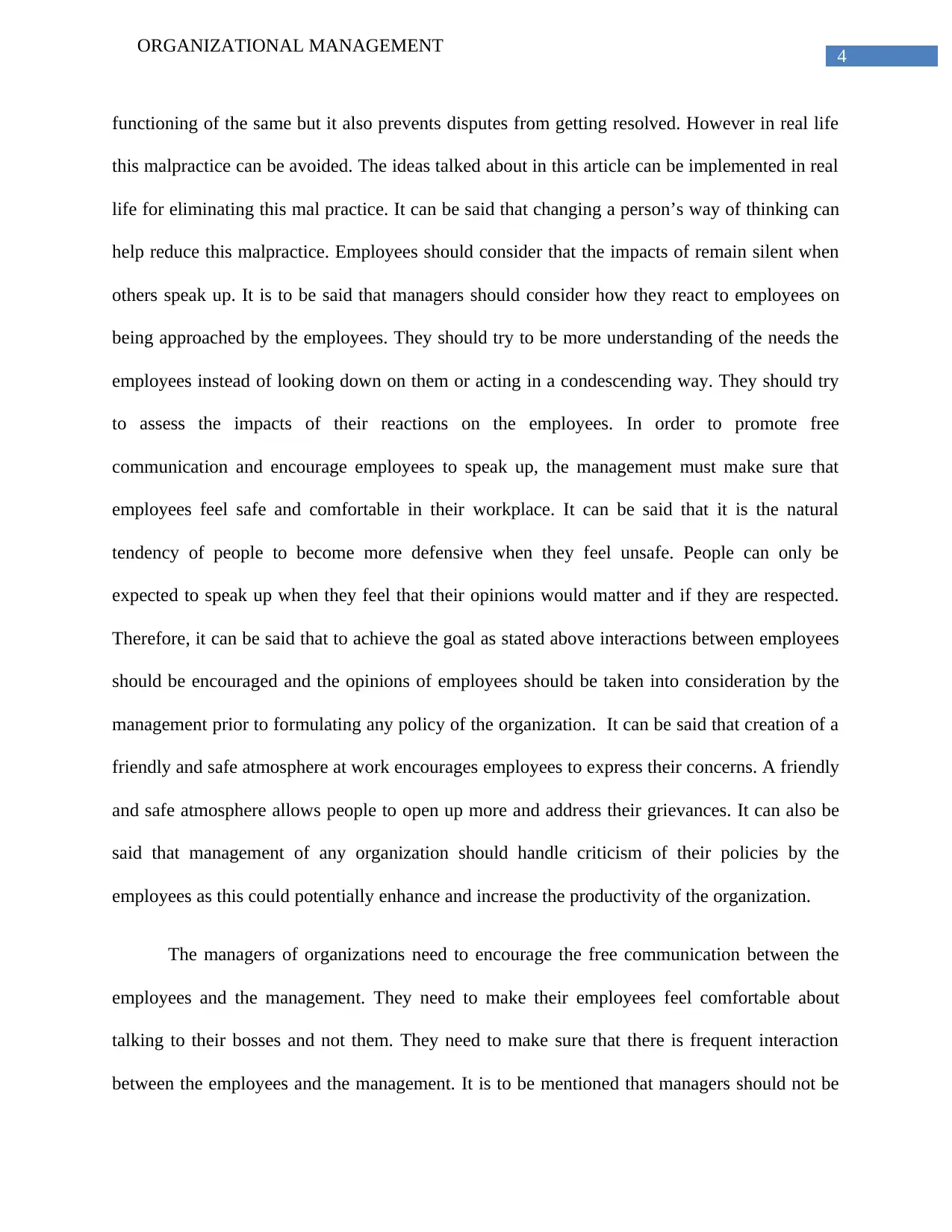
4
ORGANIZATIONAL MANAGEMENT
functioning of the same but it also prevents disputes from getting resolved. However in real life
this malpractice can be avoided. The ideas talked about in this article can be implemented in real
life for eliminating this mal practice. It can be said that changing a person’s way of thinking can
help reduce this malpractice. Employees should consider that the impacts of remain silent when
others speak up. It is to be said that managers should consider how they react to employees on
being approached by the employees. They should try to be more understanding of the needs the
employees instead of looking down on them or acting in a condescending way. They should try
to assess the impacts of their reactions on the employees. In order to promote free
communication and encourage employees to speak up, the management must make sure that
employees feel safe and comfortable in their workplace. It can be said that it is the natural
tendency of people to become more defensive when they feel unsafe. People can only be
expected to speak up when they feel that their opinions would matter and if they are respected.
Therefore, it can be said that to achieve the goal as stated above interactions between employees
should be encouraged and the opinions of employees should be taken into consideration by the
management prior to formulating any policy of the organization. It can be said that creation of a
friendly and safe atmosphere at work encourages employees to express their concerns. A friendly
and safe atmosphere allows people to open up more and address their grievances. It can also be
said that management of any organization should handle criticism of their policies by the
employees as this could potentially enhance and increase the productivity of the organization.
The managers of organizations need to encourage the free communication between the
employees and the management. They need to make their employees feel comfortable about
talking to their bosses and not them. They need to make sure that there is frequent interaction
between the employees and the management. It is to be mentioned that managers should not be
ORGANIZATIONAL MANAGEMENT
functioning of the same but it also prevents disputes from getting resolved. However in real life
this malpractice can be avoided. The ideas talked about in this article can be implemented in real
life for eliminating this mal practice. It can be said that changing a person’s way of thinking can
help reduce this malpractice. Employees should consider that the impacts of remain silent when
others speak up. It is to be said that managers should consider how they react to employees on
being approached by the employees. They should try to be more understanding of the needs the
employees instead of looking down on them or acting in a condescending way. They should try
to assess the impacts of their reactions on the employees. In order to promote free
communication and encourage employees to speak up, the management must make sure that
employees feel safe and comfortable in their workplace. It can be said that it is the natural
tendency of people to become more defensive when they feel unsafe. People can only be
expected to speak up when they feel that their opinions would matter and if they are respected.
Therefore, it can be said that to achieve the goal as stated above interactions between employees
should be encouraged and the opinions of employees should be taken into consideration by the
management prior to formulating any policy of the organization. It can be said that creation of a
friendly and safe atmosphere at work encourages employees to express their concerns. A friendly
and safe atmosphere allows people to open up more and address their grievances. It can also be
said that management of any organization should handle criticism of their policies by the
employees as this could potentially enhance and increase the productivity of the organization.
The managers of organizations need to encourage the free communication between the
employees and the management. They need to make their employees feel comfortable about
talking to their bosses and not them. They need to make sure that there is frequent interaction
between the employees and the management. It is to be mentioned that managers should not be
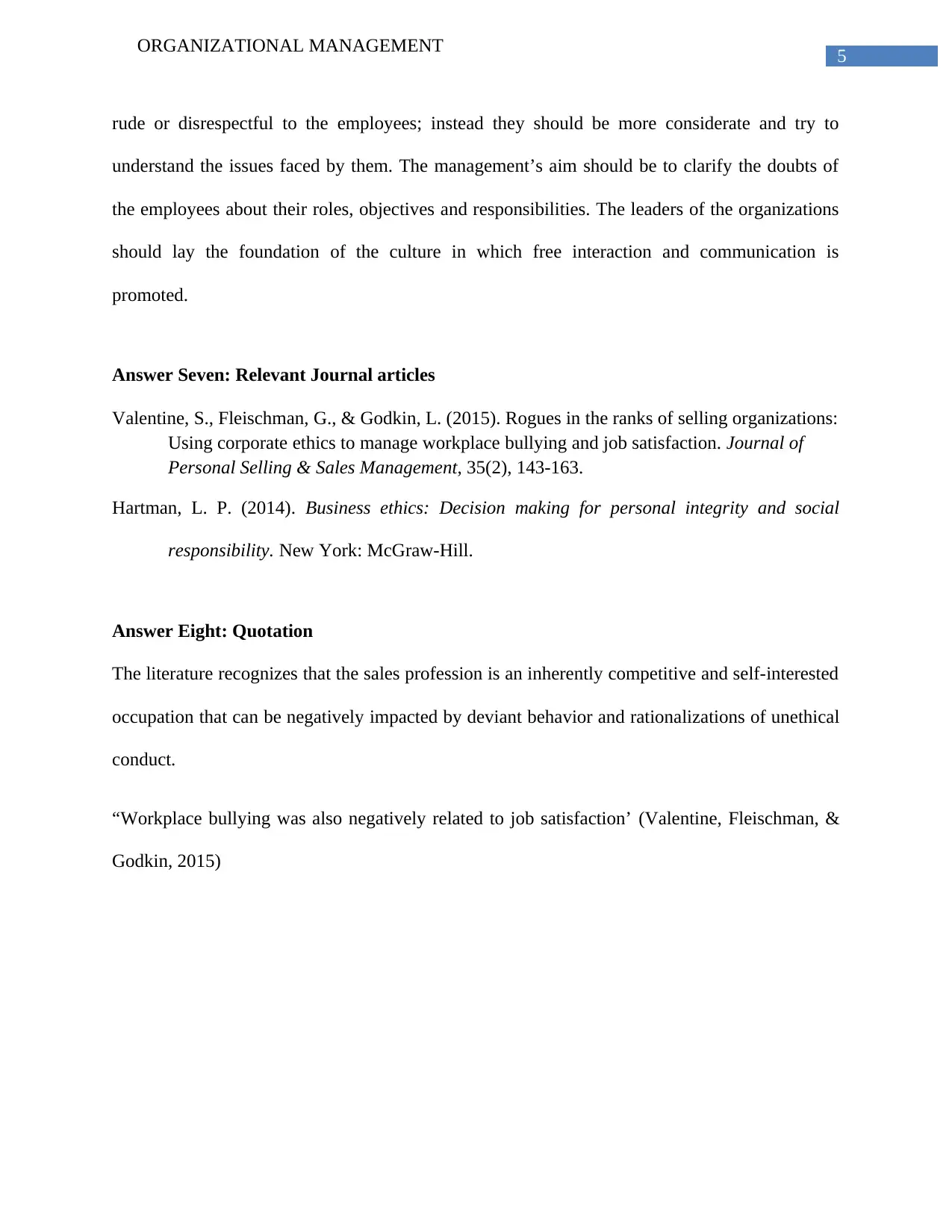
5
ORGANIZATIONAL MANAGEMENT
rude or disrespectful to the employees; instead they should be more considerate and try to
understand the issues faced by them. The management’s aim should be to clarify the doubts of
the employees about their roles, objectives and responsibilities. The leaders of the organizations
should lay the foundation of the culture in which free interaction and communication is
promoted.
Answer Seven: Relevant Journal articles
Valentine, S., Fleischman, G., & Godkin, L. (2015). Rogues in the ranks of selling organizations:
Using corporate ethics to manage workplace bullying and job satisfaction. Journal of
Personal Selling & Sales Management, 35(2), 143-163.
Hartman, L. P. (2014). Business ethics: Decision making for personal integrity and social
responsibility. New York: McGraw-Hill.
Answer Eight: Quotation
The literature recognizes that the sales profession is an inherently competitive and self-interested
occupation that can be negatively impacted by deviant behavior and rationalizations of unethical
conduct.
“Workplace bullying was also negatively related to job satisfaction’ (Valentine, Fleischman, &
Godkin, 2015)
ORGANIZATIONAL MANAGEMENT
rude or disrespectful to the employees; instead they should be more considerate and try to
understand the issues faced by them. The management’s aim should be to clarify the doubts of
the employees about their roles, objectives and responsibilities. The leaders of the organizations
should lay the foundation of the culture in which free interaction and communication is
promoted.
Answer Seven: Relevant Journal articles
Valentine, S., Fleischman, G., & Godkin, L. (2015). Rogues in the ranks of selling organizations:
Using corporate ethics to manage workplace bullying and job satisfaction. Journal of
Personal Selling & Sales Management, 35(2), 143-163.
Hartman, L. P. (2014). Business ethics: Decision making for personal integrity and social
responsibility. New York: McGraw-Hill.
Answer Eight: Quotation
The literature recognizes that the sales profession is an inherently competitive and self-interested
occupation that can be negatively impacted by deviant behavior and rationalizations of unethical
conduct.
“Workplace bullying was also negatively related to job satisfaction’ (Valentine, Fleischman, &
Godkin, 2015)
⊘ This is a preview!⊘
Do you want full access?
Subscribe today to unlock all pages.

Trusted by 1+ million students worldwide
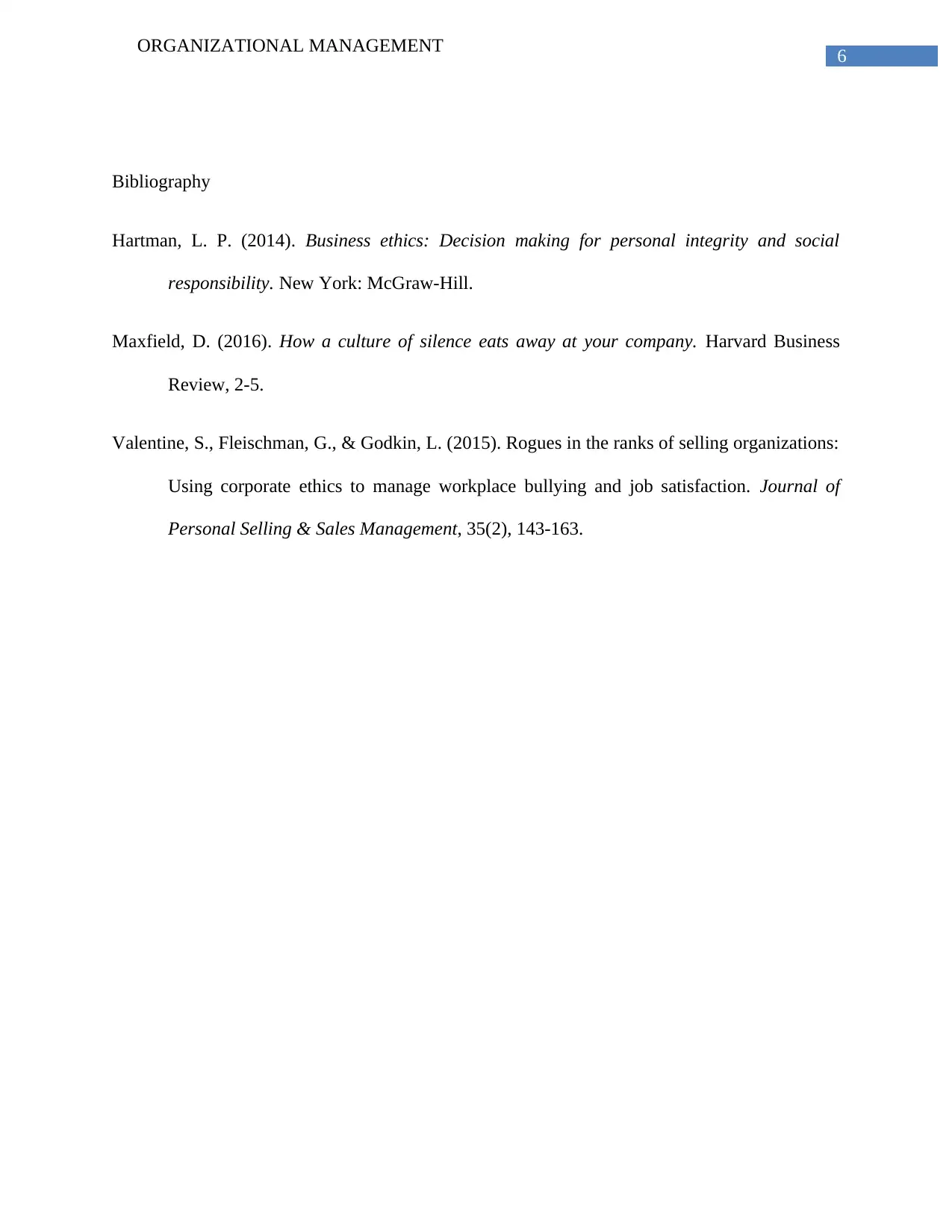
6
ORGANIZATIONAL MANAGEMENT
Bibliography
Hartman, L. P. (2014). Business ethics: Decision making for personal integrity and social
responsibility. New York: McGraw-Hill.
Maxfield, D. (2016). How a culture of silence eats away at your company. Harvard Business
Review, 2-5.
Valentine, S., Fleischman, G., & Godkin, L. (2015). Rogues in the ranks of selling organizations:
Using corporate ethics to manage workplace bullying and job satisfaction. Journal of
Personal Selling & Sales Management, 35(2), 143-163.
ORGANIZATIONAL MANAGEMENT
Bibliography
Hartman, L. P. (2014). Business ethics: Decision making for personal integrity and social
responsibility. New York: McGraw-Hill.
Maxfield, D. (2016). How a culture of silence eats away at your company. Harvard Business
Review, 2-5.
Valentine, S., Fleischman, G., & Godkin, L. (2015). Rogues in the ranks of selling organizations:
Using corporate ethics to manage workplace bullying and job satisfaction. Journal of
Personal Selling & Sales Management, 35(2), 143-163.
1 out of 7
Related Documents
Your All-in-One AI-Powered Toolkit for Academic Success.
+13062052269
info@desklib.com
Available 24*7 on WhatsApp / Email
![[object Object]](/_next/static/media/star-bottom.7253800d.svg)
Unlock your academic potential
Copyright © 2020–2025 A2Z Services. All Rights Reserved. Developed and managed by ZUCOL.





